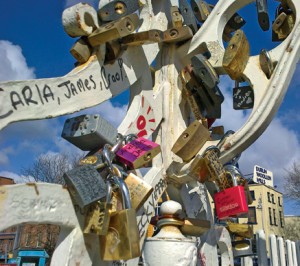
Should you stroll across Dublin’s historic Ha’penny Bridge, you’ll see it’s become part of a growing phenomenon: the Love-Lock craze.
They may seem at first glance like randomly discarded padlocks but, on closer inspection, you’ll see couples have inscribed their initials on the locks before affixing them to the structure.
Once locked to a monument, the key is then discarded, symbolically locking the couple together in love. While it’s relatively new to Dublin, the practice is said to have originated in ancient China and has been a fixture at the main tourist spots of European cities like Paris, Rome and Cologne for the last few years.
When the custom spread across the Atlantic two years ago, Connecticut resident Robert Timmons saw a chance for a business venture. He founded Lock-itz.com, a website which allows those of a romantic nature to order custom-engraved locks. Timmons tells NewsFour that, when thousands of locks began to appear on New York’s Brooklyn Bridge, he knew there was a commercial opportunity.
His site receives an average of four orders a day and Timmons has had requests from 30 countries across the globe. A maths teacher by day, Timmons’ obsession with stats allows him to tell me immediately that thus far he has received a total of 10 orders from Ireland and 30% of his orders come from outside the U.S.
Timmons told NewsFour that inscriptions range from the standard “couple’s initials” to more personal messages. “I recently engraved the message ‘I love you like a mango’ for someone,” he laughs.
Closer to home, LoveLocks U.K is the British branch of Timmons’ main competitor. Its director, Laura Tanner, informs NewsFour that the locks have now extended beyond human couples, with her company receiving several requests for locks engraved with the names of deceased pets.
The custom is one generally frowned upon by local authorities. When asked about the Ha’penny Bridge locks, a spokesman for Dublin City Council said, “It is the Council’s position to remove these locks as they will damage the protective coating if allowed to remain in place.”
Timmons is aware that locks are often placed without permission on historic structures but states that Lock-itz doesn’t encourage the practice. It’s for this reason he has sought out sponsorship from local councils to erect official sites where the locks can be placed. To date he has acquired two such locations: a park in Kansas City and the Los Gatos Art Museum in California.
Similarly, LoveLocks U.K hope to install ‘Love-Scapes’ across Britain, with one already operating in Leicestershire. “The aim this year is to get more councils on board,” Tanner tells NewsFour.
Unlike those of other countries, U.K councils seem quite tolerant of the practice. At Liverpool’s Albert Docks, a sign encourages couples to ‘interlock your padlocks on the railings and throw away the key into the Mersey’. According to Tanner, locks placed on London’s Tower Bridge are untouched by the city’s council.
Tanner tells NewsFour she plans to sell the locks to gift shops and is hoping to strike a deal with some Dublin stores. Aware of the Ha’penny Bridge situation, Timmons plans to contact Dublin City Council with the idea of establishing an officially sponsored site in the city. It seems Love-Locks are here to stay.
Above: Love-Locks on the Ha’penny Bridge, Dublin and, below, on the Hohenzollern Bridge in Cologne.
By Eric Hillis

